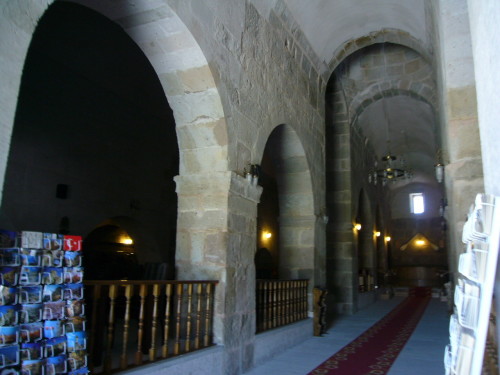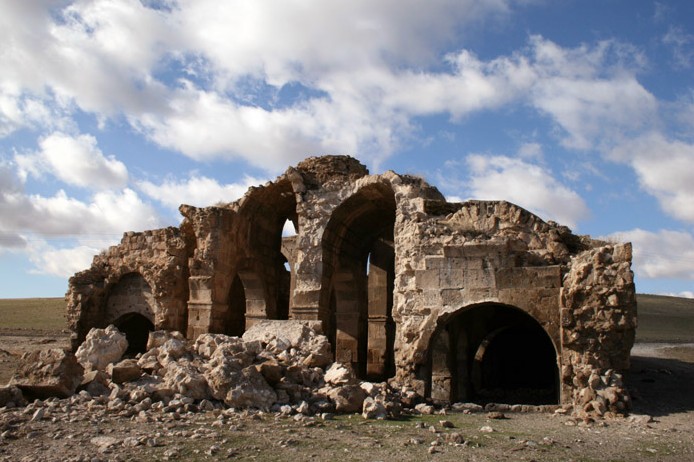ORESIN HAN
This is the first Anatolian Seljuk han dated by an inscription, attested by its recently-discovered inscription plaque.
|
the han before restoration... Karpuz, Anadolu Selçuklu Eserleri (2008) v.1, p. 69 |
|
and after.... Eravşar, 2017. p. 494; photo I. Dıvarcı |
|
photo by Ibrahim Divarci; used by permission |
|
Eravşar, 2017. p. 498; photo I. Dıvarcı |
|
|
|
Bilici, vol. 1, p. 107 |
|
plan drawn by Erdmann |
|
photo by Ibrahim Divarci; used by permission |
DISTRICT
68
AKSARAY
LOCATION
38.470745, 34.203066
The
Oresin Han
is located on the Aksaray-Nevsehir road, 21 km outside of Aksaray, at
the location of a crossroads of two caravan routes. The han was built on a
strategically important road, already in use in the Roman and Byzantine periods.
The Oresin Han is located close to two other hans: the next han in the direction
of Aksaray is the Ağzikara Han, which is only 12 km away, and in the direction
of Kayseri, the next han is the Alay Han, which is only 6 km away.
A fort built during the Roman period is located in the village of Kalebalta, northwest of the han and on the same caravan road. It continued to be used by the Byzantines and the Seljuks.
NAMES
Tepesidelik Han
Tepeli Delik Han
Öresun (Oresin) Han.
No mention of its name exists in Seljuk sources.
DATE
1188 (dated by inscription; the last two numbers are not clear)
INSCRIPTION
Until recently, the Oresin Han is considered to have been built in the third quarter of the 13th century by analysis of the stylistic features. On what must have been an very exciting day during the 2007 renovation of the han, Necdet Ozkan discovered the inscription plaque among the fallen stones. The inscription has now been placed in the tympanum of the main door.
This inscription of 3 lines is quite brief, and does not contain the benediction for the sultan or its patron. It does not include the name of the han, but gives a firm date. It comprises three lines and reads as follows:
Melih Sultan, son of Kiliç Aslan, the son of Shah the Great Sultan Mesud, had ordered this han to be built during his reign, in Hijri 584 / A.D. 1188.
This inscription does pose some questions as to its authenticity as the original construction inscription. The calligraphy is not carefully executed. The sultan mentioned is Izzeddin Kiliç Arslan II, son of Rukneddin Masud I. However, the last two numbers given for the date in the last line are illegible, but are believed to be the number 8. If it is accepted that this is the original inscription, it places the construction of the han to 1156-92 when Izzeddin Kiliç Arslan II was in power.
REIGN
OF
Sultan Kilicarslan II
PATRON
The patron of the Oresin Han is Melih Sultan Shah, the son of Kilic Arslan II.
His is also known as Kutbeddin Melikshah. Sultan Kiliç Arslan II divided the
country among his 11 sons upon his retirement, and bequeathed the sultanates of
Sivas and Ankara to his son Kutbeddin Melikshah.
BUILDING TYPE
Covered, no courtyard (C)
DESCRIPTION
The han is oriented
north-south and is built on a slight incline. The han consists of a covered
section only, and it is considered that it was originally built without a
courtyard, as no remains of a courtyard were revealed during the excavations
made to the entrance of the han. This does not mean, however, that a courtyard
was not planned, but that for a number of reasons was not built,
but it is highly probable that the han was originally planned to include one.
Covered section: The han portal faces southeast and has a large covered section with five naves. The middle nave is higher and wider than the lateral naves and runs in the north-south direction. Each nave is supported by six square piers, for a total of 24. The plan displays an unusual layout of the aisles. On either side of the central aisle are two pairs of vaults running perpendicular to the rear wall, and they are separated by a central transversal aisle running parallel to the back wall. Two additional vaults running parallel to the rear wall are located on the front and rear walls. The middle nave is divided by a lateral transept nave at the third support wall. This transept nave lies in the east-west direction and is covered with a pointed barrel vault. Each section of the lateral naves on either side of the transept nave is covered by a round barrel vault. This unusual plan creates four separate sections underneath the inner vertical pieces. It has a similar plan to the Cay Taş Han with its transept cross-section.
A dome resting on pendentives is situated at the point where the north-south middle nave crosses the east-west transept nave. The dome is covered by an octagonal pyramidal cone today. Four windows in the drum of the dome provide lighting to the interior.
Lighting was provided by slit windows located in the northern wall of the middle nave and in the east and west walls of the second and fourth cross vaults.
The raised loading platforms of the covered section were in ruins, but were rebuilt during the restoration as indicated by the original traces on the piers.
The stones of the crown door were discovered during the recent excavation project, and it has been restored. The opening is composed of a pointed arch with a flattened arch over the door. The marble inscription plaque has been reinstalled in its place over the door.
The han was described by the travelers Oberhummer and Zimmerer, who saw it in 1898. They said that the han was built in the village next to a river, and that it had 5 naves and was covered by a central dome. This village no longer exists. Rott visited the han at the beginning of the century and called it the Weresin Han in his journal. It is marked as the Oresun Han on the maps of Kiepert.
EXTERIOR
There are two support towers at the center of the east and west walls.
Traces of a well and various architectural remains were discovered in the tumulus in front of the han.
BUILDING MATERIALS
The han was built using cut-stones filled with a mixture of rubble and mortar. The walls of this han are thinner than those seen in most other hans. Of note in this han are the higher than average vault springings. Sources mention that spolia reuse materials from a church were installed in the northern corner of the building. The Oresun Han features different characteristics from other hans in its use of spolia. All the arches and vaults in the closed section are round, which is not found in other Seljuk hans. This can probably be explained due to the fact that the entire building was constructed from the stones transferred here from a nearby Byzantine building and were adapted to the plan of the han. Due to their round shapes, the forms of the arches and vaults of the building are different from Seljuk designs. The design proportions in Seljuk buildings were not practiced in the Oresun Han.
DECORATION
It is not possible to document the original portal decoration in
view of the current ruined state.
DIMENSIONS
Area of covered section: 727m2
Outer area: 560m2
STATE OF CONSERVATION, CURRENT USE
In 2007, the Turkish General Foundations Directorate ordered a complete
restoration of the han, which was completed in 2010. The dome at the center of
the transepts of the covered section has been covered with a pointed dome. The
han has now been turned into
a tourist restaurant and gift shop.
Although little of the han remained standing before the renovation, the pendentives on the dome, the architectural proportions and the workmanship were impressive. The portal and part of the dome were in ruins, but the spaces covered by cradle vaults and supported by symmetrically placed groups of three columns around the pendentive dome were striking in appearance. It has been entirely renovated and has lost all of its original structural properties.
This proud and dignified sentinel stood for many years on this lonely stretch of road, poetically evoking the passage of the Seljuks, Crusaders, and Mongols on these plains.
BIBLIOGRAPHIC REFERENCES
Akok, Mahmut. Öresin Han ve Hizir Ilyas Köskü. Belleten, 1958, vol. 21, pp. 139-148.
Baş A. Öresun (Tepsi Delik) Haninda Temizlik ve Restorasyon Çalişmalari. 13. Ortacağ ve Türk Dönemi Kazilar ve Sanat Tarihi Araştirmalari Sempozyumu Birdirilere 14-16 ekim 2009, 2010, pp. 71-73.
Bektaş, C. Selçuklu Kervansaraylari, Korumalari ve Kullanilmalari Üzerine Bir Öneri. Istanbul, 1999, pp. 106-107.
Bell, Gertrude. The Gertrude Bell Archives. Internet web document. www.gerty.ncl.ac.uk/, folder I, photo I-211 (1907).
Bilici, Z. Kenan. Anadolu Selçuklu Çaği Mirası. Mimarı = Heritage of Anatolian Seljuk Era. Architecture. 3 vols. Ankara: Türkiye Cumhuriyeti Cumhurbaşkanlığı: Selçuklu Belediyesi, 2016, vol. 1, pp. 105-107.
Eravşar, O. Spolia in Seljuk Buildings. in SOMA 2014: Proceedings of the 18th Symposium on Mediterranean Archaeology. Wroclaw, 2014, pp. 167-182.
Eravşar, Osman. Yollarin Taniklari (Witnesses of the Way), 2017, pp. 494-498.
Erdmann, Kurt. Das Anatolische Karavansaray des 13. Jahrhunderts, I, Berlin, 1961, pp. 167-169, no. 51.
Görür, Muhammet. Anadolu Selçuklu Dönemi Kervansaraylari Kataloğu. Acun, H. Anadolu Selçuklu Dönemi Kervansaraylari. Ankara: Kültür ve Turizm Bakanliği, 2007, p. 517.
Hild, F. Das byzantinische Strassensystem in Kappadokien, 1977, p. 71.
Hild, F. & Restle, M. Tabula Imperii Byzantini 2 Kappadokien, 1981, p. 249.
Hillenbrand, R. Islamic Architecture: Form, function and meaning, 1994, fig. 6.57, p. 553.
Karpuz, H. & Kuş, A. & Dıvarcı, I. & Şimşek, F. Anadolu Selçuklu Eserleri, 2008, vol. 1, p. 69.
Kiepert, R. Karten von Kleinasien in 24 Blatt bearbeitet, 1902-1916.
Konyalı, İ. H. Abideleri ve Kitabeleriyle Niğde Aksaray Tarihi I, Istanbul, 1974.
Oberhummer, R. & Zimmerer, H. Durch Syrien und Kleinasien, 1899, p. 253.
Özergin, M. Kemal. Anadoluda Selçuklu Kervansarayları, Tarih Dergisi, XV/20, 1965, p. 158, n. 92.
Ozgüç, T. & Akok, M. Alayhan, Öresunhan ve Hizirilyas Köşkü Iki Selçuklu Kervansarari ve Bir Köşkü. Belleten 21 (8), 1957, pp. 1-84.
Redford, S. Reading Inscriptions on Seljuk Caravanserais. Eurasiatica 4, 2016, pp. 221-233.
Rice, Tamara Talbot. The Seljuks in Asia Minor, 1961, p. 206.
Rott, H. F. Kleinasien Denkmaler aus Psidien, Pamphylien, Kappadokien und Lykien, 1908, p. 255.
|
Eravşar, 2017. p. 496; photo I. Dıvarcı |
|
|
|
 |
|
|
|
|
the photos below show the han before the 2009 renovation: |
|
 |
|
|
|
|
The Oresin Han had a bit role in the 1970 film "You Can't Win 'em All", directed by Peter Collinson and starring Charles Bronson and Tony Curtis as soldiers of fortune for the Ottoman Sultan in 1922. The film was shot in the region of Avanos, and there is a brief scene where the mounted soldiers pass in front of the han. Bronson and Curtis observe the han and comment on how nothing withstands the passage of time, not even a monument as impressive as this one. In his memoirs, Bronson recalls the challenges of shooting in the 120 degree broiling heat of the Anatolian summer.
|
|
|
|
|
|
©2001-2025, Katharine Branning; All Rights Reserved.